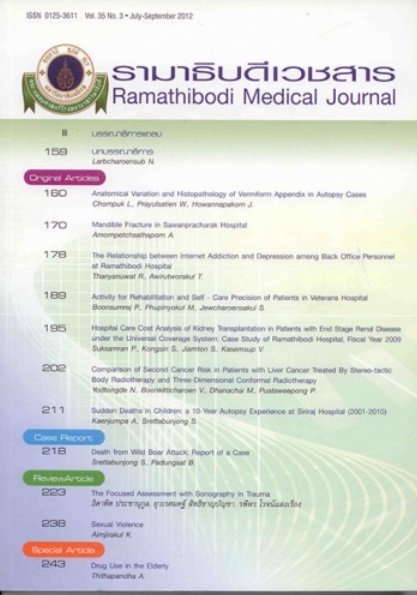Comparison of Second Cancer Risk in Patients with Liver Cancer Treated By Stereo-tactic Body Radiotherapy and Three-Dimensional Conformal Radiotherapy
Keywords:
SBRT, 3D-CRT, Second cancers, Organ equivalent doseAbstract
Background: Stereotactic body radiotherapy (SBRT) is suggested to pose higher second cancer risk than conventional three-dimensional conformal radiotherapy (3D-CRT) for generating greater scatter/ leakage dose to distant organs. Epidemiological reports indicate the need to include primary beam effect in risk assessment because of its great contribution to total cancer risk.
Objective: To determine the second cancer dosimetric index, organ equivalent dose (OED), for organ in treatment field (planning target volume, PTV), beam border (uninvolved liver), and distant area (stomach and pancreas) in patients with liver cancer treated either by Cyberknife SBRT (Cyber-SBRT) or 3D-CRT.
Methods: Treatment plans for seven patients were optimized and prescription dose of 45 Gy were delivered in 15 Gy x3 fractions for Cyber-SBRT and 1.8 Gy x25 fractions for 3D-CRT. OED for primary beam was calculated from differential dose volume histogram. Image-guided dose and scatter/ leakage dose from each treatment were measured in Rando phantom using thermoluminescence dosimeters.
Results: For primary beam component, OEDs of PTV were comparable for both treatments (p = 0.00003). In organs outside the treatment field, Cyber-SBRT generated much lower OEDs than 3D-CRT (p £ 0.059). OEDs for scatter/ leakage component were smaller for 3D-CRT but their contributions to total OEDs were < 1%. OED from image-guided procedure in Cyberknife SBRT was relatively small. In overall, total OEDs were comparable between Cyber-SBRT and 3D-CRT.
Conclusion: Total OEDs of normal tissues from both treatments were comparable or apparently lower for SBRT than 3D-CRT (p ³ 0.20) while total OED of PTV from Cyber-SBRT is slightly higher than that of 3D-CRT (p < 0.05).
References
Ben-Josef E, Lawrence TS. Radiotherapy for unresectable hepatic malignancies. Semin Radiat Oncol. 2005;15(4):273-8. doi:10.1016/j.semradonc.2005.04.006.
Dawson LA, McGinn CJ, Normolle D, Ten Haken RK, Walker S, Ensminger W, et al. Escalated focal liver radiation and concurrent hepatic artery fluorodeoxyuridine for unresectable intrahepatic malignancies. J Clin Oncol. 2000;18(11):2210-8. doi:10.1200/JCO.2000.18.11.2210.
Stenmark MH Liu E, Schipper MJ, Ben-Josef E, Lawrence TS, Feng MU. SBRT outcome for primary and metastatic liver lesions [ASCO Meeting Abstracts]. J Clinical Oncology. 2011;26:262. https://ascopubs.org/doi/abs/10.1200/jco.2011.29.4_suppl.262.
Gunvén P, Blomgren H, Lax I, Levitt SH. Curative stereotactic body radiotherapy for liver malignancy. Med Oncol. 2009;26(3):327-34. doi:10.1007/s12032-008-9125-4.
Dörr W, Herrmann T. Cancer induction by radiotherapy: dose dependence and spatial relationship to irradiated volume. J Radiol Prot. 2002;22(3A):A117-21.
Schneider U, Kaser-Hotz B. Radiation risk estimates after radiotherapy: application of the organ equivalent dose concept to plateau dose-response relationships. Radiat Environ Biophys. 2005;44(3):235-9. doi:10.1007/s00411-005-0016-1.
Hall EJ. The inaugural Frank Ellis Lecture--latrogenic cancer: the impact of intensity-modulated radiotherapy. Clin Oncol (R Coll Radiol). 2006;18(4):277-82. doi:10.1016/j.clon.2006.02.006.
Schneider U, Walsh L. Cancer risk estimates from the combined Japanese A-bomb and Hodgkin cohorts for doses relevant to radiotherapy. Radiat Environ Biophys. 2008;47(2):253-63. doi:10.1007/s00411-007-0151-y.
Emami B, Lyman J, Brown A, Coia L, Goitein M, Munzenrider JE, et al. Tolerance of normal tissue to therapeutic irradiation. Int J Radiat Oncol Biol Phys. 1991;21(1):109-22. doi:10.1016/0360-3016(91)90171-y.
Timmerman RD. An overview of hypofractionation and introduction to this issue of seminars in radiation oncology. Semin Radiat Oncol. 2008;18(4):215-22. doi:10.1016/j.semradonc.2008.04.001.
Tai A, Li XA, Dawson L. Adaptive Radiation Therapy for Liver Cancer, In: Li XA. ed. Adaptive Radiation Therapy. CRC Press, Taylor & Francis; 2011:313-29.
Joiner M, ver der Kogel A. Basic Clinical Radiobiology.4th ed. London, UK: Hodder Arnold; 2009.
Fowler JF. The linear-quadratic formula and progress in fractionated radiotherapy. Br J Radiol. 1989 ;62(740):679-94. doi:10.1259/0007-1285-62-740-679.
Murphy MJ, Balter J, Balter S, BenComo JA Jr, Das IJ, Jiang SB, et al. The management of imaging dose during image-guided radiotherapy: report of the AAPM Task Group 75. Med Phys. 2007 ;34(10):4041-63. doi:10.1118/1.2775667.
Scalzetti EM, Huda W, Bhatt S, Ogden KM. A method to obtain mean organ doses in a RANDO phantom. Health Phys. 2008;95(2):241-4. doi:10.1097/01.HP.0000310997.09116.e3.
Sharma SD, Upreti RR, Laskar S, Tambe CM, Deshpande DD, Shrivastava SK, et al. Estimation of risk of radiation-induced carcinogenesis in adolescents with nasopharyngeal cancer treated using sliding window IMRT. Radiother Oncol. 2008;86(2):177-81. doi:10.1016/j.radonc.2007.11.019.
International Commission on Radiological Protection. Report on the Task Group on Reference Man, ICRP Publication 23. Oxford: Pergamon Press; 1975.
Schneider U, Zwahlen D, Ross D, Kaser-Hotz B. Estimation of radiation-induced cancer from three-dimensional dose distributions: Concept of organ equivalent dose. Int J Radiat Oncol Biol Phys. 2005;61(5):1510-5. doi:10.1016/j.ijrobp.2004.12.040.













